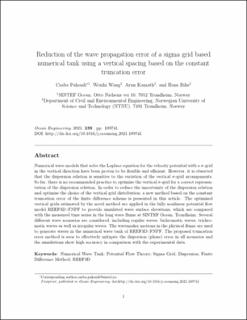| dc.contributor.author | Pakozdi, Csaba | |
| dc.contributor.author | Wang, Weizhi | |
| dc.contributor.author | Kamath, Arun | |
| dc.contributor.author | Bihs, Hans | |
| dc.date.accessioned | 2021-10-07T09:22:18Z | |
| dc.date.available | 2021-10-07T09:22:18Z | |
| dc.date.created | 2021-09-30T10:42:09Z | |
| dc.date.issued | 2021 | |
| dc.identifier.citation | Ocean Engineering. 2021, 239, . | en_US |
| dc.identifier.issn | 0029-8018 | |
| dc.identifier.uri | https://hdl.handle.net/11250/2788334 | |
| dc.description.abstract | Numerical wave models that solve the Laplace equation for the velocity potential with a -grid in the vertical direction have been proven to be flexible and efficient. However, it is observed that the dispersion relation is sensitive to the variation of the vertical -grid arrangements. So far, there is no recommended practice to optimise the vertical -grid for a correct representation of the dispersion relation. In order to reduce the uncertainty of the dispersion relation and optimise the choice of the vertical grid distribution, a new method based on the constant truncation error of the finite difference scheme is presented in this article. The optimised vertical grids estimated by the novel method are applied in the fully nonlinear potential flow model REEF3D::FNPF to provide simulated wave surface elevations, which are compared with the measured time series in the long wave flume at SINTEF Ocean, Trondheim. Several different wave scenarios are considered, including regular waves, bichromatic waves, trichromatic waves as well as irregular waves. The wavemaker motions in the physical flume are used to generate waves in the numerical wave tank of REEF3D::FNPF. The proposed truncation error method is seen to effectively mitigate the dispersion (phase) error in all scenarios and the simulations show high accuracy in comparison with the experimental data. | en_US |
| dc.language.iso | eng | en_US |
| dc.publisher | Elsevier Science | en_US |
| dc.rights | Attribution-NonCommercial-NoDerivatives 4.0 Internasjonal | * |
| dc.rights.uri | http://creativecommons.org/licenses/by-nc-nd/4.0/deed.no | * |
| dc.subject | Havbølger | en_US |
| dc.subject | Ocean waves | en_US |
| dc.title | Reduction of the wave propagation error of a sigma grid based numerical tank using a vertical spacing based on the constant truncation error | en_US |
| dc.type | Peer reviewed | en_US |
| dc.type | Journal article | en_US |
| dc.description.version | acceptedVersion | en_US |
| dc.subject.nsi | VDP::Marin teknologi: 580 | en_US |
| dc.subject.nsi | VDP::Marine technology: 580 | en_US |
| dc.source.pagenumber | 18 | en_US |
| dc.source.volume | 239 | en_US |
| dc.source.journal | Ocean Engineering | en_US |
| dc.identifier.doi | 10.1016/j.oceaneng.2021.109741 | |
| dc.identifier.cristin | 1941181 | |
| dc.relation.project | EU/HPRI-CT-2001-00176 | en_US |
| dc.relation.project | Notur/NorStore: NN2620K | en_US |
| dc.relation.project | Norges forskningsråd: 267981 | en_US |
| dc.description.localcode | This is the authors' accepted manuscript to an article published by Elsevier. Locked until 9 September 2023 due to copyright restrictions. The AAM is made available under the CC-BY-NC-ND 4.0 license http://creativecommons.org/licenses/by-nc-nd/4.0/ | en_US |
| dc.source.articlenumber | 109741 | en_US |
| cristin.ispublished | true | |
| cristin.fulltext | postprint | |
| cristin.qualitycode | 1 | |

